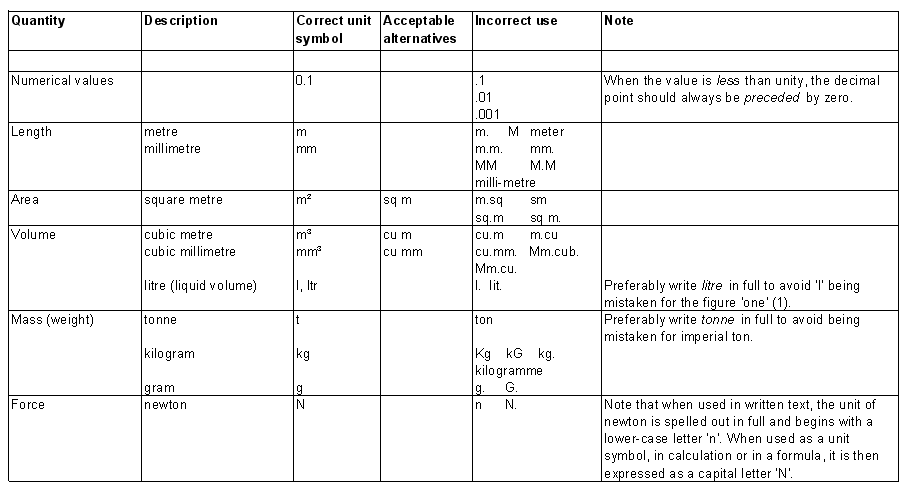Units
The term ‘units’ can have several different applications in the context of the built environment.
The term can refer to devices that form part of a more complex mechanism and have a specified function. For example; air handling units, chiller units, consumer units, fan coil units and so on.
It can also refer to a unit of measurement, which is used as a standard for measuring similar items. When any other quantity of the same kind is measured it can be expressed in those units. For example, the physical quantities of length or height. Metres, centimetres and millimetres are units of length that represent a definite predetermined length. In other words, 5 metres refers to five times the predetermined length of a metre.
The International System of Units (SI) is the most commonly adopted system of units.
The main units that are used are as shown in table below.
The same unit symbol, i.e. m, mm, kg, should be used for singular and plural values (e.g. 1 kg, 10 kg), and no full stops or any other punctuation marks should be used after the symbol, unless it occurs at the end of a sentence.
For more information, see Notation and units on drawings and documents.
Units can also refer to parts of a buildings or development, such as a ‘housing unit’; that is, a separate and independent dwelling that is intended for habitation by a single household. Since 2001, a dwelling has been defined as a self-contained unit of accommodation. This can include individual houses as well as individual flats within a tower block.
In project management, the term unit might be used to refer to a group of workers responsible for a particular element of the project.
[edit] Related articles on Designing Buildings
Featured articles and news
RTPI leader to become new CIOB Chief Executive Officer
Dr Victoria Hills MRTPI, FICE to take over after Caroline Gumble’s departure.
Social and affordable housing, a long term plan for delivery
The “Delivering a Decade of Renewal for Social and Affordable Housing” strategy sets out future path.
A change to adoptive architecture
Effects of global weather warming on architectural detailing, material choice and human interaction.
The proposed publicly owned and backed subsidiary of Homes England, to facilitate new homes.
How big is the problem and what can we do to mitigate the effects?
Overheating guidance and tools for building designers
A number of cool guides to help with the heat.
The UK's Modern Industrial Strategy: A 10 year plan
Previous consultation criticism, current key elements and general support with some persisting reservations.
Building Safety Regulator reforms
New roles, new staff and a new fast track service pave the way for a single construction regulator.
Architectural Technologist CPDs and Communications
CIAT CPD… and how you can do it!
Cooling centres and cool spaces
Managing extreme heat in cities by directing the public to places for heat stress relief and water sources.
Winter gardens: A brief history and warm variations
Extending the season with glass in different forms and terms.
Restoring Great Yarmouth's Winter Gardens
Transforming one of the least sustainable constructions imaginable.
Construction Skills Mission Board launch sector drive
Newly formed government and industry collaboration set strategy for recruiting an additional 100,000 construction workers a year.
New Architects Code comes into effect in September 2025
ARB Architects Code of Conduct and Practice available with ongoing consultation regarding guidance.
Welsh Skills Body (Medr) launches ambitious plan
The new skills body brings together funding and regulation of tertiary education and research for the devolved nation.
Paul Gandy FCIOB announced as next CIOB President
Former Tilbury Douglas CEO takes helm.
UK Infrastructure: A 10 Year Strategy. In brief with reactions
With the National Infrastructure and Service Transformation Authority (NISTA).























